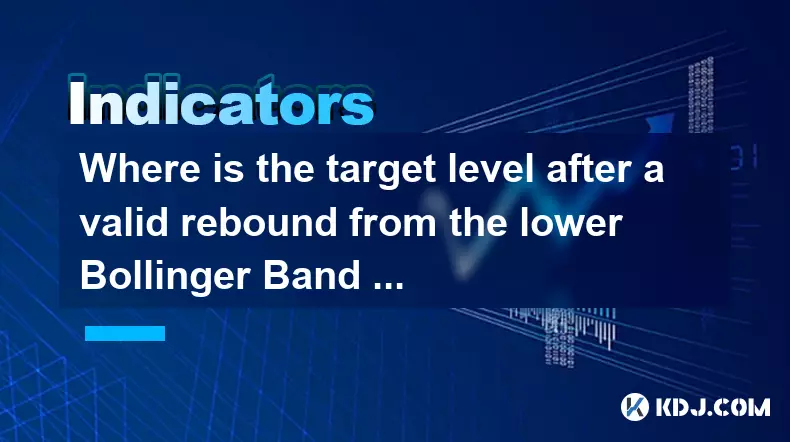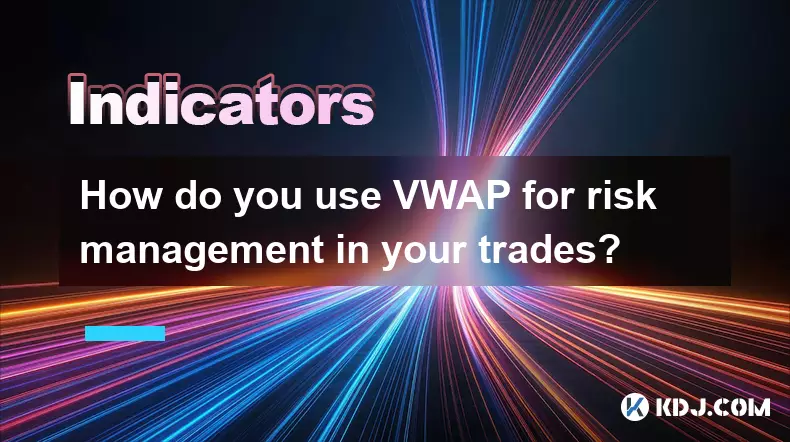-
 bitcoin
bitcoin $114684.631706 USD
-0.87% -
 ethereum
ethereum $4228.677447 USD
1.58% -
 bnb
bnb $1294.880693 USD
-1.16% -
 tether
tether $1.000819 USD
-0.02% -
 xrp
xrp $2.605138 USD
2.79% -
 solana
solana $209.908690 USD
5.89% -
 usd-coin
usd-coin $0.999903 USD
-0.03% -
 dogecoin
dogecoin $0.213423 USD
2.93% -
 tron
tron $0.322721 USD
-0.10% -
 cardano
cardano $0.727247 USD
3.66% -
 hyperliquid
hyperliquid $42.339456 USD
6.05% -
 chainlink
chainlink $19.910811 USD
5.16% -
 ethena-usde
ethena-usde $1.000557 USD
0.00% -
 stellar
stellar $0.349734 USD
2.69% -
 bitcoin-cash
bitcoin-cash $543.848687 USD
-0.21%
Where is the target level after a valid rebound from the lower Bollinger Band support level?
A bounce from the lower Bollinger Band, confirmed by volume and momentum, often targets the middle SMA first, then the upper band in crypto's volatile markets.
Oct 05, 2025 at 09:00 am

Understanding Bollinger Bands in Crypto Trading
1. Bollinger Bands consist of three lines: the middle band, typically a 20-day simple moving average (SMA), and upper and lower bands that represent standard deviations from the mean. These bands dynamically adjust based on market volatility, expanding during high volatility and contracting during low volatility.
2. The lower Bollinger Band acts as a potential support level in downtrends or consolidation phases. When price touches or briefly dips below this band, it may indicate oversold conditions, especially if accompanied by strong volume or reversal candlestick patterns.
3. A valid rebound occurs when price interacts with the lower band and closes back inside the bands, supported by bullish momentum signals such as RSI divergence or MACD crossover. This suggests short-term selling pressure has exhausted and buyers are stepping in.
4. Traders monitor for confirmation through subsequent candles forming higher lows and closing progressively above the previous candle’s close, reinforcing the validity of the bounce.
5. In the context of cryptocurrency markets, which often exhibit exaggerated price swings, Bollinger Band rebounds can signal sharp countertrend moves, particularly after panic-driven sell-offs seen during market corrections.
Identifying the Target After a Rebound
1. The initial target following a confirmed bounce from the lower band is typically the middle SMA (20-day SMA). Price often gravitates toward this mean line after extreme deviations, making it a natural first resistance zone.
2. If momentum continues, the next logical target becomes the upper Bollinger Band. This represents overbought territory and historically acts as dynamic resistance. In trending markets, price may ride along the upper band, extending gains further.
3. Fibonacci retracement levels derived from the prior swing high to swing low can be overlaid to refine targets. Common retracement zones like 50%, 61.8%, and 78.6% frequently align with Bollinger Band midpoints or upper boundaries, enhancing their reliability.
4. Volume analysis plays a crucial role—increasing volume on the rebound increases confidence in reaching higher targets. Conversely, weak volume suggests a false bounce and limited upside potential.
5. In ranging markets, the opposite end of the range often coincides with the upper band, making it a high-probability exit point. In trending environments, partial profits may be taken at the upper band while allowing runners to capture extended momentum.
Practical Application in Bitcoin and Altcoin Charts
1. On Bitcoin’s 4-hour chart, repeated touches of the lower Bollinger Band during bearish phases have preceded sharp rallies toward the middle and upper bands, especially when aligned with positive macro news or on-chain accumulation signals.
2. For altcoins like Ethereum or Solana, Bollinger Band rebounds often coincide with sector-wide sentiment shifts. For example, after a broad selloff in DeFi tokens, a bounce from the lower band with rising open interest in futures can precede rapid recovery moves.
3. Leverage trading data enhances interpretation—high long liquidations preceding a bounce suggest capitulation, increasing the likelihood of a strong move toward the upper band.
4. Divergences between price and oscillators such as Stochastic RSI strengthen the case for sustained upward movement post-rebound. A bullish divergence while price is near the lower band often precedes multi-candle rally sequences.
5. Scalpers use micro bounces off the lower band on 5-minute or 15-minute charts to target quick moves to the middle band, exiting within minutes. Position traders wait for daily closes above the middle band before committing larger capital.
Valid rebounds from the lower Bollinger Band often target the middle SMA first, then the upper Bollinger Band, especially when confirmed by volume and momentum indicators.
Frequently Asked Questions
What confirms a valid bounce from the lower Bollinger Band?A close back inside the bands, supported by rising volume and bullish candlestick patterns such as hammers or bullish engulfing formations, confirms validity. Additional confirmation comes from momentum indicators showing reversal signals.
Can price continue falling even after touching the lower band?Yes, especially during strong downtrends or black swan events. The lower band is not a guaranteed floor; breakdowns below it followed by continued closes outside the band signal sustained bearish control.
How do Bollinger Bands perform in sideways versus trending crypto markets?In sideways markets, bands act as reliable support and resistance, with price oscillating between them. In strong trends, price can ride along the upper or lower band for extended periods, making reversals riskier to trade.
Is the upper Bollinger Band always a sell signal?Not necessarily. In uptrends, touching the upper band can indicate strength rather than overbought conditions. Selling solely based on upper band touch without confluence from other indicators can lead to missed rallies.
Disclaimer:info@kdj.com
The information provided is not trading advice. kdj.com does not assume any responsibility for any investments made based on the information provided in this article. Cryptocurrencies are highly volatile and it is highly recommended that you invest with caution after thorough research!
If you believe that the content used on this website infringes your copyright, please contact us immediately (info@kdj.com) and we will delete it promptly.
- XRP Price Prediction: Weekend Rollercoaster or Rally?
- 2025-10-12 08:45:16
- Bittensor (TAO): Super Bullish Signals Point to Potential 2x Rally
- 2025-10-11 10:25:12
- Silver Price Correction: Navigating the Dip & Identifying Key SEO Keywords
- 2025-10-11 10:25:12
- Decoding Crypto Trends: Bittensor's Bull Run, Cardano's Dip, and LivLive's Presale Buzz in 'Uptober 2025'
- 2025-10-12 08:45:16
- MoonBull: The Crypto Meme Coin Promising 1000x Gains?
- 2025-10-11 10:30:01
- Crypto Payroll Revolution: Stablecoins, Altcoins, and the Future of Salary Payments
- 2025-10-11 10:30:01
Related knowledge

What's the main difference between VWAP and TWAP?
Oct 12,2025 at 11:54am
Understanding VWAP and Its Role in Crypto Trading1. Volume Weighted Average Price (VWAP) is a trading benchmark that calculates the average price of a...

How do you identify exhaustion moves using VWAP and its bands?
Oct 12,2025 at 08:00am
Understanding the Role of Decentralized Exchanges in Crypto Trading1. Decentralized exchanges (DEXs) operate without a central authority, allowing use...

How do you use VWAP to scale in and out of positions?
Oct 14,2025 at 02:19am
Understanding VWAP as a Dynamic Benchmark1. The Volume Weighted Average Price (VWAP) is not just an indicator—it functions as a dynamic benchmark that...

What are the main advantages of using VWAP over EMA?
Oct 11,2025 at 02:18am
Main Advantages of Using VWAP Over EMA1. Volume-Weighted Average Price (VWAP) incorporates trading volume into its calculation, offering a more accura...

How do you use VWAP on different chart types like Heikin Ashi?
Oct 11,2025 at 05:01pm
Understanding VWAP in the Context of Heikin Ashi Charts1. The Volume Weighted Average Price (VWAP) is a powerful analytical tool commonly used by trad...

How do you use VWAP for risk management in your trades?
Oct 11,2025 at 02:54am
Understanding VWAP as a Dynamic Benchmark1. The Volume Weighted Average Price (VWAP) serves as a crucial reference point in intraday trading by reflec...

What's the main difference between VWAP and TWAP?
Oct 12,2025 at 11:54am
Understanding VWAP and Its Role in Crypto Trading1. Volume Weighted Average Price (VWAP) is a trading benchmark that calculates the average price of a...

How do you identify exhaustion moves using VWAP and its bands?
Oct 12,2025 at 08:00am
Understanding the Role of Decentralized Exchanges in Crypto Trading1. Decentralized exchanges (DEXs) operate without a central authority, allowing use...

How do you use VWAP to scale in and out of positions?
Oct 14,2025 at 02:19am
Understanding VWAP as a Dynamic Benchmark1. The Volume Weighted Average Price (VWAP) is not just an indicator—it functions as a dynamic benchmark that...

What are the main advantages of using VWAP over EMA?
Oct 11,2025 at 02:18am
Main Advantages of Using VWAP Over EMA1. Volume-Weighted Average Price (VWAP) incorporates trading volume into its calculation, offering a more accura...

How do you use VWAP on different chart types like Heikin Ashi?
Oct 11,2025 at 05:01pm
Understanding VWAP in the Context of Heikin Ashi Charts1. The Volume Weighted Average Price (VWAP) is a powerful analytical tool commonly used by trad...

How do you use VWAP for risk management in your trades?
Oct 11,2025 at 02:54am
Understanding VWAP as a Dynamic Benchmark1. The Volume Weighted Average Price (VWAP) serves as a crucial reference point in intraday trading by reflec...
See all articles










































































